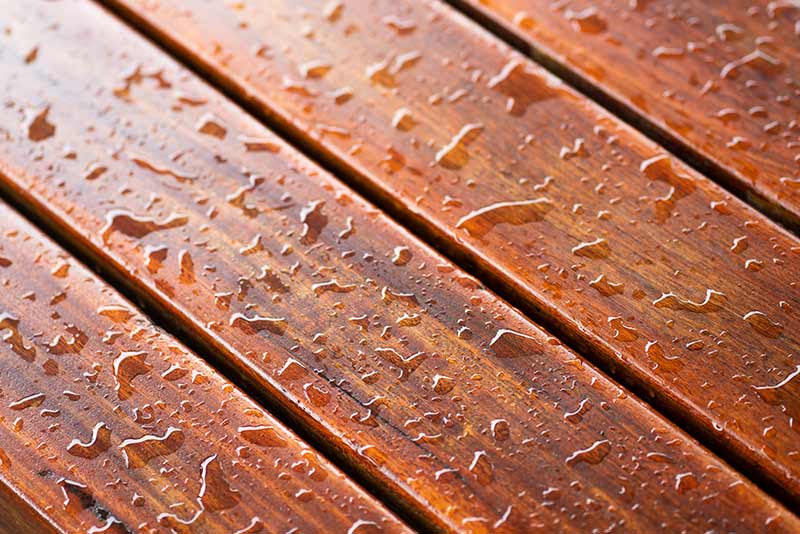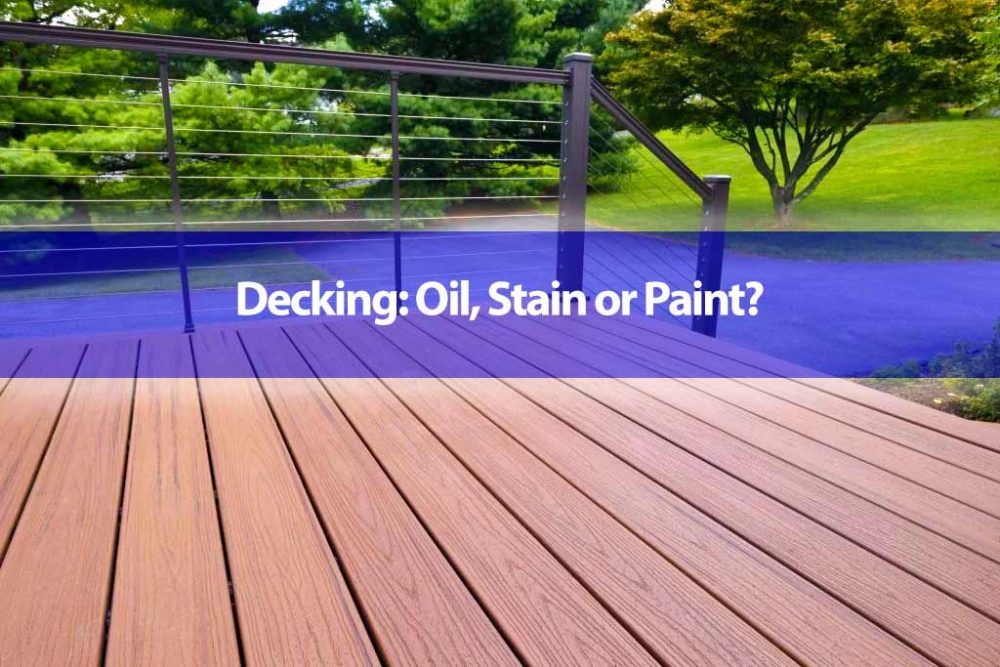All Blogs, Priming and Protecting, Varnish and Wood Oils
Decking: Oil, Stain or Paint?
Wood is a fabulous natural material, ideal for decking but it has to take a fair old battering. Hot, dry, wet, cold…we get all the weather here in the UK…combine that with regular foot traffic and it’s clear to see why a deck can look scruffy, fairly quickly.
But with proper care and the right treatment, you can keep your wooden decking looking beautiful for many years. Here is the information you’ll need to help you on the way.
Does a New Wooden Deck Need Treating?
A lot of commercially sold decking comes pressure treated (or tannalised – it’s the same thing) or pre-treated with preservative in some way. Pressure treating is an industrial process whereby preserver is forced into the middle of the wood via mechanical pressure (as the name suggests). Another form of pre-treatment is dip treatment, where wood is immersed in preserver and then left to dry. Some decking boards are supplied untreated – if yours is not treated then it’s important to apply a wood preserver as soon as possible. A wood preserver helps prevent wood rotting, decaying and succumbing to woodworm and similar insects.
How to Tell if Decking Wood is Pre-Treated?
Usually the best way to tell if your decking boards are pressure treated or pre-treated in any way is to ask your supplier. If they don’t know or you cannot contact them, you can often tell by the colour of the wood which is often a green or greyish brown shade. Further treatment should not be immediately necessary unless an alternative finish is desired or you simply want immediate additional protection.
What Causes Decking to Lose its Looks?
When it’s first laid, a deck always looks fantastic, but like all wood, it needs maintenance and care to stay looking this way. The first step in good maintenance is…and none of us really like to acknowledge this…regular proper cleaning. The relatively easy part is to keep on top of the sweeping, so that damp and dirt cannot collect under leaves or sticks and general grime build up is kept to a minimum.
Growth of moss, algae and mildew ruins the look of the wood, but more importantly can make it slippery and dangerous. Mould and mildew thrive in dark, damp surroundings so if your decking is in the shade or under overhanging trees, you will certainly have noticed this. Jet washing can make already damaged decking worse because the force of the jet can enlarge existing cracks and splinters allowing water ingress, leading to rot. Using a good mould and algae removal product is important – mould is a living organism so off the shelf general cleaners may not do the trick.
We love to recommend Barrettine products here – they know what they’re doing when it comes to woodcare and their mould and mildew cleaner is ideal for cleaning decking.
UV rays and moisture also contribute to the weathering or ‘silvering’ of timber. If you prefer the original ‘unweathered’ golden colour of wood, you can restore its natural wood colour using Barrettine’s wood reviver. This product effectively reverses the greying process using oxalic acid which is found naturally in many plants. Take a look at the video on the product here…it really is amazing!
Which product to use on Decking?
Depending on the type of finish you want, there are various options for decking. Here you’ll need to think about:
- The existing condition of your decking
- The type of appearance you want
- The amount of ongoing maintenance you are willing to put in.
Here’s an overview of decking oils, stains and paints with their upsides and downsides:
Decking Oil: Why…Why Not?
If decking is in good condition and you prefer the natural beauty of the wood to remain evident, then a decking oil is a good choice. Oil penetrates well, is easy to apply and is also simple to re-apply in future years. Oil penetrates deep into the wood to help protect decking against both water and UV damage. Decking oils help to restore wood’s natural oils which contributes to ongoing nourishment and keeps the boards supple. A deck treated with oil will not blister or peel in the way other coatings can.
Because they absorb well into the surface, oils tend not to be as slippery as some stains and coatings that create a film rather than penetrating into the wood. Where re-treatment is necessary, it is easy to accomplish with relatively little surface preparation; spot-treatment in high traffic areas is also easy with a decking oil.
The downside of using an oil is that while it will offer protection, it won’t cover up damaged wood or change the ‘look’ of existing decking. Oils provide a translucent finish and even with tinted oils, the natural texture and grain of wood will still be apparent.
Another disadvantage of decking oil is that you cannot paint/stain over it if you don’t like the appearance until it has completely weathered. The weathering process to get to this stage can be years. If you want to paint or stain before it has reached this stage, the best thing to do is remove as much of the existing oil as possible. It may however, be possible to seal/prime the wood and paint with an oil based paint – check with your supplier.
Should a coloured or opaque finish be required then decking oil is not the product to choose. While decking oils are available in shades, they tend to be natural wood colours rather than solid colours such as grey, green, blue etc.

Decking Oil Tips:
- Some woods do not take oil as well as others, check the wood type – softwoods tend to absorb oil better than hardwoods and some woods like teak already have a high oil content so may need an alternative oil. Check the product to ensure it is suitable for your wood type before purchasing
- When re-oiling decking, we recommend you use the same product. If this isn’t possible then at the very least, ensure you don’t swap between water based and oil based decking oil
- How often to retreat? Usually every 12 to 24 months
- Any wood oil may change the natural colour of the wood so test an inconspicuous area to ensure you’re happy
Decking Stain: Why…Why Not?
Decking stains vary from brand to brand, so you need to check carefully – especially if you need protection as well as ‘colour’. Some stains are stain/oil combinations and some have added UV protection etc. If you want to change the colour more dramatically, then look for a highly pigmented stain. Generally, decking stain will provide a consistent application of colour and most will not completely hide the grain of the wood. Stains usually have a good rate of coverage compared to paint and they are quick drying, so are a good choice if you are limited on time. Decking stains act by creating a film or seal to the surface which offers wood good protection against foot traffic and general weathering. The downside of this is that if the seal is weakened or broken, moisture can get in and cause peeling or cracking.
Most decking stains do not provide the water repellency and nourishment of a decking oil, though some combination oil/stain products such as Barrettine All in One Decking oil will provide water repellency, UV protection and stain . The colour tints are however limited to natural wood shades and the finish is translucent.
If a future colour change is desired after using a decking stain, or the surface becomes cracked or flaky, usually the existing stain must first be removed before a new stain is applied. As with many other wood products, a stain will not take/adhere if decking oil has previously been applied.
Decking Stain Tips:
- Just as with decking oil, you’ll need check the type and finish of your wood before purchasing a decking stain. Hardwoods and softwoods have different absorbencies so quantity needed may vary and new, oily woods may not ‘take’ the stain, so will need to weather for a while
- Decking stain will need re-applying every 12 to 24 months, although those that are more heavily pigmented can last a lot longer
- More solid-pigmented stains will show less of the wood grain
- Undertake a test patch to check you are happy before proceeding with the entire area
- Keep pets away from the decking until it’s fully dry (details will be on the tin but varying ambient conditions will affect drying times)
Decking Paints: Why…Why Not?
Should an alternative appearance like a solid, opaque colour be your preference then painting is an option. Choose a paint that you know is suitable for walking on – many great quality exterior paints are designed for application to vertical or sloping surfaces and may not cope with standing water or foot traffic.
An advantage of painting decking is that paint tends to cover flaws, cracks and fading and it is easier to achieve a consistent finish.
There is also a much wider range of colours and some manufacturers will colour match too. This is great if you want to create an impact or contrast with other garden colours.
Painted decking can usually be ‘touched up’ in future years for a quick temporary refresh (only temporary – eventually it will need stripping and re-doing). Paint will give good protection to your decking boards as it provides a good seal against moisture. Keep an eye however, on the condition of the surface; if moisture gets in, it may trap under the ‘seal’ of the paint and rot the wood.
Decking paint will not show the natural grain and colour of wood in the same way as oil or stain. Unlike decking oil, or oil/stain combinations, paint will not be absorbed into the wood to give it the same nourishment and protection.
Decking Paint Tips:
- If painting over previously oiled or stained decking board, ideally you should remove as much of it as you can. You can sometimes seal/prime weathered (previously treated) decking and paint with an oil based paint. Ask us for recommendations as water based products will rarely adhere to this type of surface
- Preparation is crucial when painting – do not apply decking paint to damp wood and be sure to allow sufficient drying time between coats
- Try to remove water promptly in areas where it might be ‘pooling’
- As above, try a test patch first! If you don’t like it, paint is hard to remove
So we hope we’ve provided you with some facts to help you choose your deck’s oil, stain or paint. Whatever you choose, do clean and prepare before applying any products and wait for a dry weather spell. Always follow the instructions on the tin and remember, stirring actually means stirring!
Check it out on a small patch before covering the entire deck and if more than one coat is recommended, allow time to dry between coats.
Contacting us is easy!
Email: [email protected]
Call Us: 01942 884 122
Contact form: https://www.palatinepaints.co.uk/contact-us
As always, we welcome comments below. We also have our online chat manned each weekday during working hours or call/email.

